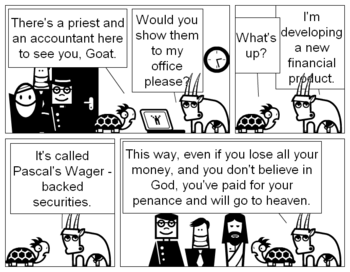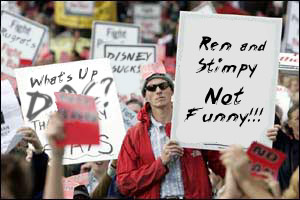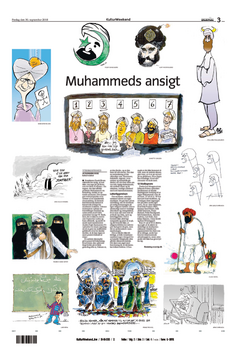Political cartoon
Political cartoons are cartoons that express complex socio-political issues in a single panel, trading in-depth analysis for a crude drawing and a saying the cartoonist believes is pithy. And, where in-depth analysis of complex socio-political issues tends to bring readers to the brink of sleep, political cartoons tend to bring readers to the very brink of laughter.
Format[edit | edit source]
Political cartoons typically feature one or more grossly deformed caricatures of well-known politicians or public figures engaged in a static, easy-to-draw situation that distracts the reader very little from the insightful political commentary. These situations include politicians giving speeches, politicians talking with one another, and politicians talking to someone else.
Reports exist of well-drawn political cartoons, or political cartoons with more than a single panel, but these could not be independently verified as of press time. I mean, as I finished this article.
Characteristics of the Political Cartoon[edit | edit source]
Political cartoons thrive on hyperbole and exaggeration, and, to a lesser degree, humor. Symbolism is also heavily used. For example, instead of drawing the entire Republican Party, American political cartoonists use a work-around such as drawing an elephant, which takes up far less space than thousands upon thousands of white conservatives and their Latino lackeys.
Symbolism also allows political cartoons to reach a broader audience: while people with college educations might nearly giggle when a cartoon Jack Abramoff gives a sack of money to an elephant, illiterate high-school dropouts might nearly chuckle at the thought of giving an elephant a sack of money.
Can I Be A Political Cartoonist?[edit | edit source]
The field of political cartooning, which seems inaccessible to those who have never cartooned or studied politics before, is actually quite accessible. One can become a political cartoonist easily as picking up a pencil and a newspaper! Here's how:
- Pick up a copy of the Washington Post. Although other research papers are acceptable substitutes, the Post is published in Washington, which is widely regarded as the capitol of the United States.
- Find a picture of a politician and the corresponding article. Read the article. Does it inspire some kind of "opinion" in your mind? Think hard - your cartoon depends on your ability to have an "opinion!"
- Take a piece of paper and a pencil or another type of writing implement. Draw a caricature of the politician shown in your copy of the Post: this is called the poorly-drawn caricature. Now, have the politician in your cartoon say something pithy, or clever, or absurd in a way that relates both to the issue you read about and your opinion about it! This element is called the obvious gag.
- Proofread your cartoon. Does your caricature barely resemble the politician you intend to satirize? Is the obvious gag obvious enough? If you answered "yes" to either or both questions, you're almost there!
- Cut out your political cartoon and use glue or tape to attach it to your copy of the Post. Find a friend and show him or her your work. Congratulations! You're a political cartoonist!
Purpose of Political Cartoons[edit | edit source]
Political cartoons are a fun and easy way to criticize current events without having to resort to tedious activities such as research, reading, or comprehending said current events. Political cartoons make criticism of difficult issues as easy as doodling on a napkin - why, even words are optional! One might say political cartooning makes political commentary available to the illiterate, but don't tell a political cartoonist that - you might find yourself hilariously lampooned as some kind of retarded duck! Then who'd be the fool? You, not the political cartoonist, you, that's who! Ha! Look at you, you're a retarded duck!
Writing Critically or Drawing Critically?[edit | edit source]
If a politician in your country does something controversial, such as voting for a law or bill that would seem contrary to their normal behavior, or having sex with a sheep, there are several courses of action available to the critic who wishes to express themselves in print. Two of these, however, involve a rudimentary grasp of the written word.
- Using expertise or applied knowledge, examine the issue and then deconstruct it in a dispassionate way, making cogent observations, arguments and conclusions based upon research and turning them into an informed editorial.
- Use your minimal writing ability and inherent bias to trivialize details of the issue and shit out an uneven, illogical criticism more fitted for a tabloid than a respected journalistic publication, thereby creating an op-ed piece.
- Draw a funny picture and have it have something vaguely to do with the issue: questionably pithy statement optional. Voila! The political cartoon is at hand.
Controversies[edit | edit source]
In early 2005, Danish newspaper Jyllands-Posten printed twelve political cartoons of the Prophet Muhammed doing wacky things like asploding all over the face, in an attemp to spite muslims for their radical rejection of depictions of their prophet. Karl Rothenfield, chief editor of the newspaper, explained the decision behind the publication:
"As a major world religion, Islam is roughly 600 years behind Christianity, and thousands of years behind Judaism and Hinduism. So, we have at least that much time to go before Islam develops a sense of humor about itself, which it clearly does not have at this moment."
Later, Mr. Karl would critizise a crude drawing of Jesus Christ with an erection for being blasphemous and heretic.
Millions upon millions of Muslims gnashed their teeth, hurled rocks and smashed Danishes in response to the cartoons, which were regarded as poorly drawn and not nearly as funny as its editors thought they were. The Islamic World had turned on its hallowed, pious ear, now that the country of Denmark had violated the shar'ia law, despite the troublesome fact that Denmark is not ruled by Islamic (shar'ia) law.
Meanwhile, the editors at Jyllands-Posten were laughing their ass off for the chaos these muslims were causing over what they described "just some simple drawings". However, they would later regret their decision, as it would implode in their face -quite literally.
Is There a Future for Political Cartoons?[edit | edit source]
Not really. You should probably try to become a porn artist instead.




